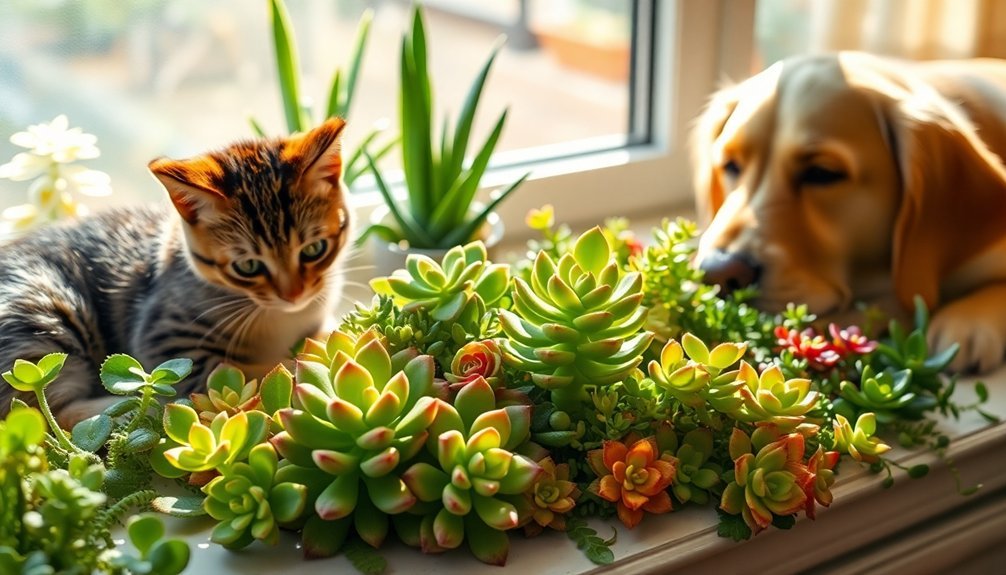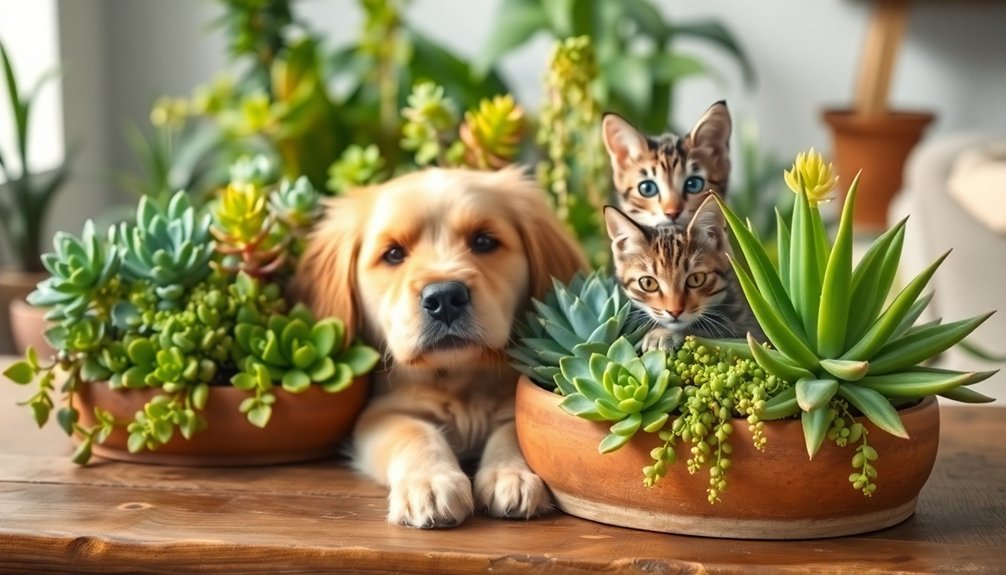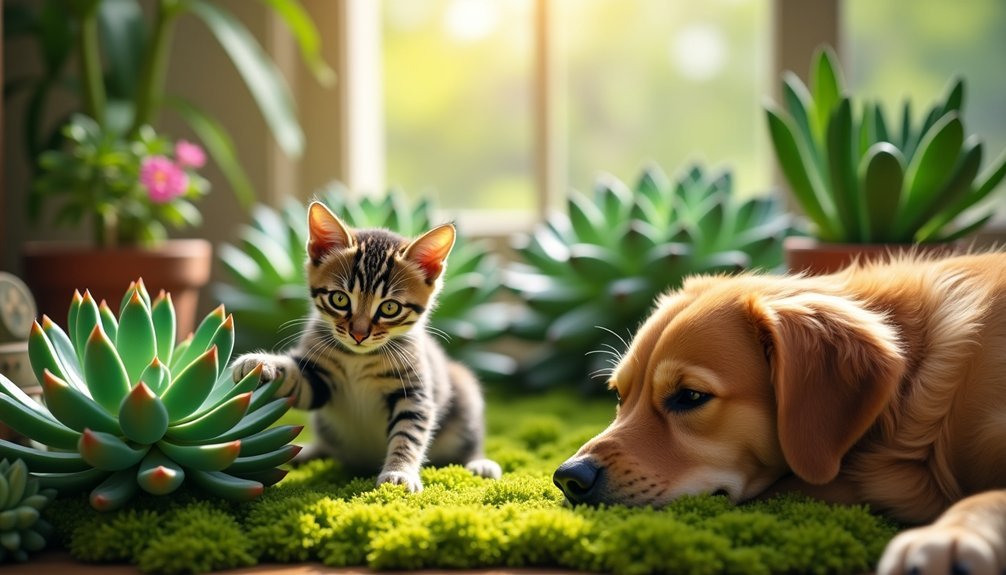If you're a pet owner who loves greenery, you can safely grow several beautiful succulent varieties that won't harm your furry friends. Choose pet-friendly options like Echeveria, Haworthia, or Sempervivum (Hens & Chicks), while avoiding toxic varieties such as Jade or Kalanchoe. Place your succulents in bright, indirect light and use well-draining soil for best results. Keep plants on high shelves or in hanging baskets to protect both your pets and plants. Let's explore more ways to create your perfect pet-friendly succulent garden.
Why Pet-Safe Succulents Matter for Your Home

While many indoor plants can pose risks to pets, choosing the right succulents for your home can create a safer, healthier environment for both you and your furry companions.
You'll want to prioritize non-toxic varieties that can effectively purify your indoor air, reducing the risk of respiratory issues for everyone in your household.
When you're selecting succulents, it's essential to identify pet-safe options and keep toxic varieties out of reach. Beautiful options like Hen and Chicks make excellent choices for pet owners looking to add greenery safely. If you're unsure about a plant's safety, you can always consult resources like the ASPCA's poison control hotline.
These hardy plants adapt well to various conditions, making them perfect for busy pet owners who want to maintain a stylish, health-conscious home.
You'll appreciate their low-maintenance nature while they work quietly to improve your home's air quality.
Best Non-Toxic Succulents for Pet Owners
Are you ready to transform your home with pet-friendly greenery? You'll love these non-toxic succulents that keep your furry friends safe while adding natural beauty to your space.
The Haworthia, Echeveria, and Gasteria species top the list of pet-safe options. They're easy to care for and thrive in bright, indirect light with minimal watering. The Sempervivum rosettes form beautiful mats that naturally spread and thrive in various light conditions. For unique visual appeal, consider the stone-like Lithops or the charming Elephant Bush with its fleshy leaves and reddish-brown stems.
| Succulent | Light Needs | Special Features |
|---|---|---|
| Haworthia | Indirect | Summer blooms |
| Echeveria | Adaptable | Colorful rosettes |
| Gasteria | Indirect | Rare indoor blooms |
| Sedum | Versatile | Drought-tolerant |
These varieties don't just look stunning – they're also hardy and forgiving, making them perfect for both novice gardeners and experienced plant parents.
Signs Your Succulent Might Be Dangerous to Pets

Because many common household succulents can harm your pets, it's crucial to recognize the warning signs of toxic varieties.
Look out for plants that produce white latex sap, like Euphorbia species, as this indicates potential skin and eye irritants. If you notice your succulent has thick, gel-filled leaves like Aloe vera, keep it out of reach – these contain aloin, which can cause severe digestive issues.
Watch for plants in the Crassulaceae family, including Jade plants and Kalanchoe species. These are particularly dangerous to both cats and dogs. Fortunately, many ornamental plant options exist among succulents that are perfectly safe for your pets.
If you're unsure about a succulent's safety, check for these symptoms in your pets: vomiting, diarrhea, lethargy, drooling, or changes in urine color.
You'll also want to monitor for any loss of coordination or appetite changes, as these can signal succulent poisoning.
Creating a Pet-Friendly Succulent Garden
Creating a pet-safe succulent garden starts with strategic placement of your plants on high shelves, in hanging baskets, or behind physical barriers where curious paws can't reach them.
You'll want to establish distinct zones that separate your pets from your succulents, using decorative fencing, raised beds, or designated plant rooms.
Beyond placement, consider incorporating natural deterrents like citrus peels or pet-safe repellent sprays around your succulent displays to keep your furry friends at a safe distance.
Safe Plant Location Tips
When designing a pet-friendly succulent garden, strategic plant placement can mean the difference between a thriving display and constant damage from curious pets. You'll want to position your non-toxic succulents in elevated spots or protected areas while maintaining easy access for maintenance.
| Location | Benefits | Best For |
|---|---|---|
| Raised Beds | Keeps plants out of reach | Larger succulent displays |
| Window Boxes | Natural sunlight, pet-free zone | Small trailing varieties |
| Hanging Baskets | Maximum protection, visual interest | Cascading succulents |
Create dedicated pet zones with smooth pathways between plant areas, and install water features in shaded spots away from your succulents. Remember to place delicate varieties in containers or behind natural barriers, while keeping hardier specimens in areas where your pets frequently roam.
Design With Pet Barriers
To protect both your pets and plants, strategic barriers serve as essential elements in a pet-friendly succulent garden.
You'll want to incorporate low fences or raised planters to create boundaries between your pets and any potentially harmful plants. Position spiky succulents away from high-traffic areas where your pets play or rest.
Create designated pet-safe zones using non-toxic groundcovers and pet-friendly succulents like Sempervivum and Sedum Donkey Tail.
You can use rocks and stones not just for aesthetic appeal but also as natural barriers to guide your pets along safe pathways. Consider adding elevated mounds and swales to separate different garden areas while adding visual interest.
Remember to maintain clear pathways using materials like gravel or decomposed granite so your pets can easily navigate through their designated spaces.
Essential Care Tips for Pet-Safe Succulents

As you begin growing pet-safe succulents, mastering proper care techniques guarantees both your plants and pets stay healthy.
Position your succulents in bright, indirect light near filtered windows, though some varieties like ponytail palms can handle direct sun.
Plant your succulents in well-draining soil using a mix of cactus soil and perlite. You'll want to water thoroughly but sparingly, letting the soil dry completely between waterings to prevent root rot.
Maintain temperatures between 60-85°F and make sure good air circulation.
While caring for your plants, don't forget to protect them from curious pets.
Try natural deterrents like coffee grounds on the soil or create a protective barrier using pine cones. You can also spray pet-repellent solutions made from vinegar, citrus, or essential oils like peppermint and lavender.
Identifying Safe vs. Toxic Succulent Species
When selecting succulents for your pet-friendly home, you'll need to look for key visual identifiers like the tight rosette patterns of Echeveria and the smooth, plump leaves of Haworthia.
You can spot potentially toxic succulents by watching for telltale signs like milky sap (common in Euphorbia species) or pearl-like formations (as seen in the dangerous String of Pearls).
Keeping a quick-reference safety chart of common succulent species can help you make informed decisions, especially when distinguishing between similar-looking safe and toxic varieties.
Pet-Safe Visual Identifiers
Since keeping pets safe around succulents requires careful plant selection, learning to identify toxic and non-toxic species is essential.
You'll find that safe succulents often display distinct characteristics. Look for plants with rosette formations and compact leaves, like Echeveria and Sempervivum, or striped foliage typical of Haworthiopsis.
Gasteria's paddle-shaped leaves and Portulacaria's shrubby growth are also reliable indicators of pet-safe varieties.
Be wary of plants that produce white latex sap, as this typically indicates a toxic Euphorbia species.
Avoid plants like Jade (Crassula) and Senecio succulents, which can cause your pets gastrointestinal distress.
While some toxic varieties may be attractive hanging plants, it's best to choose from the many pet-safe alternatives available.
Common Toxic Warning Signs
Learning to spot toxic succulents can mean the difference between a safe and hazardous environment for your pets.
Watch out for plants in the Crassula family, including popular varieties like Jade Plant and String of Buttons, which contain dangerous glycosides and alkaloids.
You'll also want to avoid any Euphorbia species, such as pencil cactus and crown of thorns, as they're toxic to both cats and dogs.
If you notice your pet drooling, vomiting, or showing signs of lethargy after contact with a succulent, take immediate action.
Bufadienolides, found in plants like the Panda Plant, can seriously affect your pet's heart and organs.
Keep the ASPCA Animal Poison Control Center's number (888-426-4435) handy, and don't hesitate to call if you suspect plant poisoning.
Quick Reference Safety Chart
To help you quickly identify safe and dangerous succulents for your pets, we've organized common species into an easy-to-reference chart.
Safe Succulents:
- Echeveria: Plump leaves, rosette formation
- Haworthia: Small, spiky appearance
- Sedum: Both tender and hardy varieties
- Sempervivum: Commonly called Hens & Chicks
- Lithops: Stone-like appearance
Toxic Succulents – Keep Away:
- Aloe Vera: Causes vomiting and diarrhea
- Crassula (Jade): Leads to GI issues
- Euphorbia: Harmful sap and spikes
- Kalanchoe: Known toxicity risks
- Euphorbia trigona/milii: Irritating sap and spines
If you're unsure about a plant's safety, consult the ASPCA's Toxic Plants List or contact the Pet Poison Helpline before adding it to your collection.
Decorating With Pet-Friendly Succulents

When decorating with pet-friendly succulents, you'll need to balance aesthetics with safety and practicality. Consider placing cascading varieties like Burro's Tail in hanging planters, keeping them safely out of your pets' reach while creating visual interest from above.
You can create stunning combination planters using non-toxic varieties like Echeveria, Haworthia, and Ghost Plant. These work beautifully together on high shelves or windowsills where pets can't access them.
For added protection, try displaying your succulents in decorative cages or open terrariums that allow proper airflow while keeping curious paws away.
Mix different colors and textures by pairing compact rosettes of Hen and Chicks with the trailing stems of Elephant Bush. These arrangements not only look stunning but guarantee your home remains pet-friendly and stylish.
Emergency Response for Succulent Poisoning
Although pet owners hope they'll never need it, knowing how to respond to succulent poisoning can save your pet's life. If your pet has consumed a toxic succulent, first remove any plant material from their mouth and surrounding area.
Don't induce vomiting without professional guidance.
Contact the ASPCA Animal Poison Control Center (888-426-4435) or Pet Poison Helpline (855-764-7661) immediately. You'll need to provide details about the plant and symptoms your pet is showing.
Watch for signs like vomiting, diarrhea, lethargy, or skin irritation. Some succulents, like Kalanchoe, can cause serious complications including heart rhythm problems.
If advised, take your pet to the vet right away, bringing the plant for identification. While waiting, keep your pet comfortable and monitor their condition closely.
Training Your Pets Around Succulents

Training your pets to respect succulent boundaries starts with establishing clear, consistent rules and using positive reinforcement when they stay away from the plants.
You'll need to combine firm commands with immediate redirection to acceptable toys while rewarding your pet with treats and praise whenever they make good choices.
Creating an engaging environment with rotating toys and puzzle feeders will help keep your pet's attention away from succulents while reinforcing the training process.
Teaching Safe Plant Boundaries
Creating safe boundaries for pets around succulents requires a well-planned combination of physical barriers and behavioral training. You'll need to establish clear markers that help your pets understand where they can and can't go in your succulent garden.
| Boundary Method | Implementation |
|---|---|
| Physical Barriers | Install short fences with consistent materials |
| Raised Beds | Elevate succulent planters 12-18 inches |
| Pathway Design | Use smooth gravel or flagstone paths |
| Natural Deterrents | Plant rosemary or sage around borders |
| Alternative Spaces | Create designated dig pits and play areas |
Set up a 2-3 foot buffer zone between your fence and succulent beds, and incorporate raised planters to naturally discourage pet access. Guide your pets along established pathways using paw-friendly materials, keeping them away from your prized plants while ensuring they have their own spaces to enjoy natural behaviors.
Reward-Based Plant Training
Successful pet owners know that reward-based training offers the most effective approach to protecting your succulents. When your pet approaches a succulent, immediately redirect their attention with a firm "no" and offer an engaging alternative like a favorite toy.
Then, reward them with treats or praise when they choose the appropriate option.
Keep your training sessions brief and consistent, using the same commands across all family members. You'll want to reward your pet during or right after they display the desired behavior, creating a clear connection between good choices and positive outcomes.
Remember to ignore mistakes rather than punishing them, which could create anxiety.
Place succulents strategically out of reach while training, but don't skip the training process. You'll need ongoing reinforcement in different settings to maintain your pet's understanding of boundaries.
Seasonal Care for Pet-Safe Succulents
As the seasons change throughout the year, pet-safe succulents require specific adjustments to their care routine to maintain ideal health.
In spring and summer, you'll want to provide bright, indirect light and moderate watering when the soil dries out. These growing months are also ideal for fertilizing with a balanced, water-soluble solution.
During winter, your succulents enter dormancy, so you'll need to reduce both watering and light exposure. Keep temperatures between 60-85°F year-round, moving plants away from drafty windows and heating vents.
You should also adjust their position seasonally, favoring east or west-facing windows for best light conditions. Remember to check for pests regularly and quarantine any new additions to your collection for several weeks before introducing them to your existing plants.
Propagating Pet-Friendly Succulent Varieties

While pet-safe succulents thrive in your home, you can expand your collection through various propagation methods.
You'll find that leaf propagation works best for thick-leaved varieties like Echeveria, while stem cuttings are ideal for trailing types such as Sedum. For clustered succulents like Sempervivum, division offers a straightforward approach to creating new plants.
- Let leaf cuttings callus for a few days before placing them in well-draining soil, keeping the medium slightly moist until roots develop.
- Take stem cuttings from healthy plants, allow them to dry, then plant them in suitable soil and water moderately.
- Separate offsets from mother plants during spring or summer, ensuring each division has roots before replanting.
For adventurous gardeners, seed propagation provides an opportunity to grow unique varieties, though it requires more patience and attention.
Frequently Asked Questions
Can Cats and Dogs Develop Allergies to Non-Toxic Succulents Over Time?
Yes, your pets can develop allergies to non-toxic succulents over time. Even if a plant's initially safe, your cat or dog might become sensitive to its sap, pollen, or other plant materials through repeated exposure.
Do Pet-Safe Succulents Attract Insects That Might Harm My Pets?
While pet-safe succulents can attract insects, they typically don't draw harmful pests. You'll want to monitor for common bugs like aphids and mealybugs, but they rarely pose serious risks to your pets.
How Long Do Pet-Friendly Succulents Typically Live Indoors?
You'll find indoor pet-friendly succulents typically live 3-10 years, but with proper care, they can thrive for decades. Your attention to watering, light, and soil conditions directly impacts their longevity.
Will Pruning Pet-Safe Succulents Make Them Toxic to Animals?
No, you don't need to worry – pruning won't make pet-safe succulents toxic to animals. The plant's toxicity is determined by its natural biology, not by pruning. Your pets will stay safe around properly maintained succulents.
Can I Mix Toxic and Non-Toxic Succulents if They're in Separate Containers?
While you can keep toxic and non-toxic succulents in separate containers, it's not recommended. You'll risk cross-contamination and confusion. For your pets' safety, it's best to keep toxic plants in a different area entirely.
In Summary
You're now ready to create a beautiful succulent garden that's completely safe for your furry friends. Remember to monitor your pets around new plants, keep your emergency vet's number handy, and continue learning about pet-safe varieties. By choosing the right succulents and following proper care guidelines, you'll enjoy these stunning plants while keeping your cats and dogs protected. Start growing your pet-friendly succulent collection today!





Leave a Reply